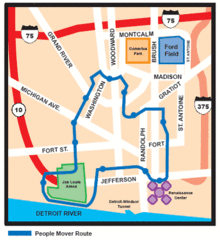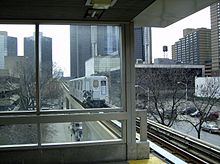- Detroit People Mover
-
Detroit People Mover 
Entering Renaissance Center station.Info Locale Downtown Detroit Transit type People mover Number of lines 1 Number of stations 13 Annual ridership 2,216,200[1] (2010)
 2.4% from 2009
2.4% from 2009Headquarters 1420 Washington Boulevard
Detroit, Michigan 48226Operation Began operation 1987 Operator(s) Detroit Transportation Corporation Number of vehicles 12 Technical Track gauge 4 ft 8 1⁄2 in (1,435 mm) Electrification Third rail System map The Detroit People Mover is a 2.9-mile (4.7 km) automated people mover system which operates on a single set of tracks, and encircles downtown Detroit, Michigan.[2]
The city's elevated light-rail system, the People Mover is operated by the Detroit Transportation Corporation of the City of Detroit. It is an important asset for business travelers, tourists, residents, and downtown workers.
The Woodward Avenue Light Rail, beginning in 2013, will serve as a link between the Detroit People Mover and SEMCOG Commuter Rail with access to DDOT and SMART buses as part of a comprehensive network of transportation in metropolitan Detroit.[3]
It uses UTDC ICTS Mark I technology and the cars are driverless. A siding allows the system to be used in a two-way bypass manner when part of the circular track is closed.
Contents
History
The Detroit People Mover has its origins in 1966, with Congressional creation of the Urban Mass Transportation Administration (UMTA) to develop new types of transit. In 1975, following the failure to produce any large-scale results and increased pressure to show results, UMTA created the Downtown People Mover Program (DPM) and sponsored a nationwide competition that offered federal funds to cover much of the cost of planning and construction of such a system. Selecting proposals from four cities, the UMTA recommended that Detroit, Miami, and Baltimore be permitted to construct systems, but only if they could do so with existing grants. Though two of the four selected cities ultimately withdrew from the program, Miami and Detroit persevered to build theirs.[4]
The People Mover was intended to be the downtown distributor for a proposed city and metro-wide light rail transit system for Detroit in the early 1980s; however, funding was scaled back.[5] At the time of planning, the system was projected to have a ridership of 67,700 daily.[6]
The system opened in 1987 using the same technology as Vancouver's SkyTrain and Toronto's Scarborough RT line. In the first year, an average of 11,000 riders used the People Mover each day; the one-day record was 54,648.[7]
When the People Mover opened, it traditionally ran counter-clockwise. In August 2008, the system changed direction and is now running clockwise permanently, although it can run in both directions when necessary. The change to clockwise meant that trains were faster.[8]
Capacity
The Detroit People Mover can accommodate a large influx of tourists to downtown. The system is designed to accommodate up to 15 million riders a year. In 2008, it served over 2 million riders. In fiscal year 1999-2000, the city spent $3.00 for every $0.50 rider fare, according to The Detroit News. Among the busiest periods was the five days around the 2006 Super Bowl XL, when 215,910 patrons used the service.[9] In 2008, the system moved about 7,500 people per day, about 2.5 percent of its daily peak capacity of 288,000.[10][11] The Mover costs about $12 million annually.[12]
Expansion
There have been proposals to extend the People Mover northward to the New Center and neighborhoods not within walking distance of the city's downtown. A proposal has been put forward by Marsden Burger, former manager of the People Mover, to double the length of the route by extending the People Mover along Woodward Avenue to West Grand Boulevard and into the New Center area.[13] New stops would include the Amtrak station, Wayne State University and the cultural center, the Detroit Medical Center, and the Henry Ford Hospital. The plan would tentatively cost $150–200 million, and would be paid for by a combination of public and private financing.[14]
Criticism
The People Mover has been criticized often for its constant breakdowns, plus its slowness, both in movement and in picking up passengers, as well as certain stops being too close to one another (like Bricktown to Greektown, which some residents joke, due to said slowness, they can walk from one stop to another faster than it would take a People Mover train to move between the two).
Ridership

Year Riders Source 1996 2,048,900 Motown Tranzit 1997 1,711,000 Motown Tranzit 1998 1,989,100 Motown Tranzit 1999 763,000 Motown Tranzit 2000 1,485,900 Motown Tranzit 2001 2,370,000 Detroit News 2002 2,186,600 Motown Tranzit 2003 1,267,900 Motown Tranzit 2004 932,400 APTA[15] 2005 1,792,900 APTA[16] 2006 2,368,300 APTA[17] 2007 2,320,600 APTA[17] 2008 2,059,600 APTA[18] 2009 2,161,300 APTA[1] 2010 2,216,200 APTA[1] Stations
Detroit People Mover Legend

Broadway Grand Circus Park 

Cadillac Center Times Square 

Greektown Michigan Avenue 


Bricktown Fort/Cass 

Renaissance Center 

Millender Center Cobo Center 
Financial District 

Joe Louis Arena 


The DPM stops at 13 stations, eight of which were built into existing buildings. Each station has original artwork.
Station Location Broadway Station Broadway and John R. Street (downtown YMCA) Grand Circus Park Station Park Street & Woodward Avenue (David Whitney Building) Times Square Station Grand River Avenue & Times Square Michigan Avenue Station Michigan Avenue & Cass Avenue Fort/Cass Station Fort Street & Cass Avenue Cobo Center Station Cass Street & Congress Street (Cobo Hall) Joe Louis Arena Station 3rd Street & Jefferson Avenue (Joe Louis Arena) Financial District Station Larned Street & Shelby Street (150 West Jefferson) Millender Center Station Millender Center Apartments Renaissance Center Station Renaissance Center Bricktown Station Beaubien Street & East Fort Street Greektown Station East Lafayette Street (Greektown Casino) Cadillac Center Station Gratiot Avenue & Library Street Rolling stock
- Manufacturer: Urban Transportation Development Corporation (now Bombardier Transportation)
- Type: ICTS Mark I
- # of cars: 12 cars
- Maximum speed: 56 mph[2]
The system operates in 2 car pairs.
See also
- List of rapid transit systems
- List of United States rapid transit systems by ridership
- Toronto's Scarborough RT line
- Vancouver SkyTrain
- Transportation in metropolitan Detroit
References
- ^ a b c "APTA Public Transportation Ridership Report, Q4 2010" (PDF). American. Federal Transit Administration. 8 March 2011. http://apta.com/resources/statistics/Documents/Ridership/2010_q4_ridership_APTA.pdf. Retrieved 31 March 2011.
- ^ a b The Detroit People Mover - Overview
- ^ Ann Arbor - Detroit Regional Rail Project SEMCOG. Retrieved on February 4, 2010.
- ^ The Downtown People Mover Program
- ^ Phillipp Oswalt. "Shrinking Cities,". p. 93. http://www.shrinkingcities.com/fileadmin/shrink/downloads/pdfs/WP-Band_III_Detroit.pdf. Retrieved 2009-09-07.
- ^ Wendell Cox. "Analysis of the Proposed Las Vegas LLC Monorail". p. 14. http://www.publicpurpose.com/ut-lvmono-0006.pdf. Retrieved 2007-09-20.
- ^ Detroit downtown peoplemover, advanced automated urban transit
- ^ Detroit People Mover Reopens and Makes Changes
- ^ Detroit Transportation Corporation
- ^ http://www.apta.com/research/stats/ridership/riderep/documents/08q1rep.pdf p13 as of 2008 12,000/hour * 24 hours/day = 288,000/day
- ^ Luczak, Marybeth (1998). "Is there people-mover in your future?". Railway Age. http://findarticles.com/p/articles/mi_m1215/is_n7_v199/ai_20996430.
- ^ People Mover grows up
- ^ DetroitPeopleMover2
- ^ Detroit News[1]
- ^ American Public Transportation Association, APTA Public Transportation Ridership Report, Fourth Quarter 2005.
- ^ American Public Transportation Association, APTA Public Transportation Ridership Report, Fourth Quarter 2006.
- ^ a b American Public Transportation Association, APTA Public Transportation Ridership Report, Fourth Quarter 2007.
- ^ American Public Transportation Association, APTA Public Transportation Ridership Report, Fourth Quarter 2008.
External links
People mover and monorail systems in the United States AirTrain JFK • AirTrain Newark • Detroit People Mover • Disneyland Monorail • Huntsville Hospital Tram System • Indiana University Health People Mover • JTA Skyway • Las Colinas APT System • Las Vegas Monorail • Mandalay Bay Tram • Memphis Suspension Railway • Metromover • Morgantown PRT • Seattle Center Monorail • Walt Disney World MonorailCity of Detroit Architecture · Culture · Detroit River · Economy · Freeways · Government · History · Historic places · International Riverfront · Media · Music · Neighborhoods · Parks and beaches · People · Skyscrapers · Sports · Theatre · Tourism · Transportation

Rail transport in Michigan Passenger Other Detroit People Mover · ExpressTramProposed 
Common carrier
linesHistory See also: Transportation in metropolitan DetroitCategories:- Rapid transit in Michigan
- Culture of Detroit, Michigan
- Economy of Detroit, Michigan
- ART people movers
- Detroit People Mover
- Urban people mover systems
- Railway lines opened in 1987
- Railway loop lines
Wikimedia Foundation. 2010.


